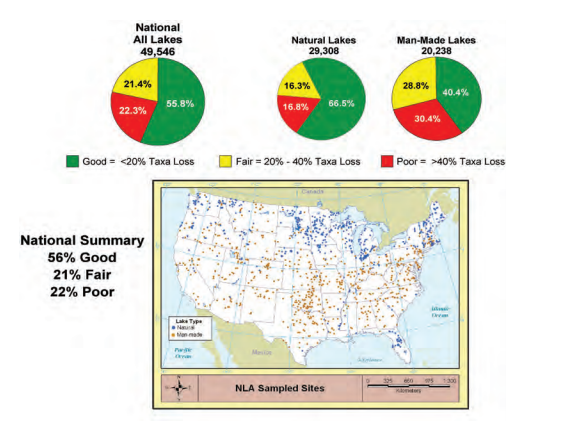National Lakes Assessment 2007 Results
The 2007 National Lakes Assessment (NLA) was the first statistical survey of the condition of our nation's lakes, ponds and reservoirs. Based on the sampling of over 1,000 lakes across the country, the survey results represent the state of nearly 50,000 natural and man-made lakes that are greater than 10 acres in area and over one meter deep. Lakes were sampled for their water quality, biological condition, habitat conditions and recreational suitability. Field crews used the same methods at all lakes to ensure that results were nationally comparable. For many of the indicators, scientists analyzed the results against a reference condition. Reference conditions were derived from a set of lakes that were determined to be the least disturbed lakes for a region.
Key findings from 2007:
Biological condition:
- 56% of the nation's lakes were in good biological condition.
- 21% of the nation's lakes were in fair condition and 22% were in poor condition.
- Natural lakes had a higher percentage of lakes in good condition (67%) than man-made lakes (40%).
Lake physical habitat:
- 36% of the nation's lakes exhibited poor shoreline habitat.
- Lakes with poor lakeshore habitat were 3 times more likely to be in poor biological health.
Nutrient pollution:
- 20% of the nation's lakes had high levels of phosphorus or nitrogen.
- Lakes with high levels of nitrogen and phosphorus were 2.5 times more likely to be in poor biological health.
Algal toxins:
- Microcystin was found to be present in about one-third of lakes and at levels of concern in 1% of lakes.
Other findings:
- Fish tissue in 49% of lakes have mercury concentrations that exceed health-based limits.
- PCBs are found at potential levels of concern in 17% of lakes.
Regional differences:
The NLA compares the biological quality of lakes, ponds and reservoirs in different parts of the country. Download the full report to read the results of this analysis.

